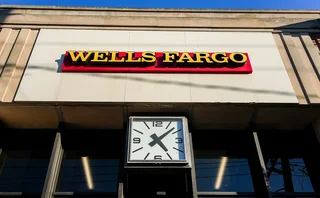
Barclays taps blockchain for equity swaps, options, swaptions
Regulatory capital savings offered by instant settlement of smart contracts on distributed ledgers

Need to know
- Barclays is looking to use 'smart contracts' for equity swaps, options and swaptions, and is seeking industry feedback in June on future test trades.
- If distributed ledger technology achieves near instantaneous settlement, dealers can set aside less regulatory capital as counterparty credit risk will be reduced.
- Markit backloaded 1 million credit default swap contracts to a blockchain at 32 contracts per second, in excess of its current storage and network capabilities.
- Establishing dispute resolution processes is a hurdle to smart contract adoption – Icap believes it can carve a role for itself here as a trusted third party.
- But London Stock Exchange Group chief executive Xavier Rolet doubts blockchain's immediate relevance to derivatives, while others say it is just a contract-recording device.
- The main challenge to solve is allowing distributed ledgers to take custody of assets – achieving simultaneous transaction of title is described as "blockchain nirvana".
Barclays is evaluating the use of so-called smart contracts in blockchain-like technology to trade equity swaps, options and swaptions.
Last month, the bank unveiled a prototype trade using distributed ledgers – the database technology behind bitcoin – to host smart contracts, which distil the terms and obligations of financial agreements into computer code.
That vanilla interest rate swap, expressed in US dollars with standard dates and terms, was just a test. It was not booked onto a derivatives portfolio, counterparties were posited as 'Bank A' and 'Bank B' and no assets were exchanged. But Lee Braine, who works in Barclays' chief technology office, says the prototype demonstrates a foundation for legally enforceable smart contracts.
The prototype used text within an International Swaps and Derivatives Association master agreement, schedule and credit support annex to create a self-executing contract. Data in those templates was used to simulate a trade entry and passed to the distributed ledger to illustrate how an end-to-end trade life cycle might work.
 Jenny Knott, Icap
Jenny Knott, Icap
Having demonstrated the viability of the user interface, Barclays will next focus on building software around data storage and middleware layers. "What it comes down to is finding a suitable way to mark up the existing Word documents," says Braine.
Barclays will also expand the model to other derivatives contracts. "We looked at a few candidate financial products for the prototype – others included equity swaps and swaptions. We chose an interest rate swap but in the coming weeks we are probably going to go back and revisit equity options. They are similar in many ways to interest rate swaps in terms of functionality. As time goes on we will look to identify, with others, the priorities for the next iteration of our prototype. I think an equity swap would be a good one," says Braine.
Barclays is part of the R3CEV consortium of 45 banks developing the distributed ledger platform Corda that was used in the test trade, but other players are also designing blockchain-type uses for derivatives.
Decentralised clearing technologist Clearmatics and margin specialist OpenGamma last month demonstrated a proof of concept showing how two counterparties can collectively value in real-time a portfolio of foreign exchange swaps using technology adapted from the Ethereum codebase, a Corda rival.
Axoni, a distributed ledger technology firm, has worked with Bank of America Merrill Lynch, Citi, Credit Suisse, JP Morgan, the Depository Trust & Clearing Corporation (DTCC) and data provider Markit to use blockchain and smart contracts in a test to manage post-trade life-cycle events for standard bilateral non-cleared North American single-name credit default swaps (CDSs) – including events inherent to CDSs such as payments, amendments, novations and compressions.
Instead of sending transactions to the DTCC's trade information warehouse, around 1 million contracts were backloaded to a blockchain, demonstrating the speed and capacity of the new technology.
Jeffrey Maron, managing director at MarkitServ, the over-the-counter derivatives trade processing arm of Markit, says the sheer volume of data was overwhelming: "The throughput was in excess of the storage and network capabilities that we have presently."
In peak periods we were processing 32 contracts a second. The value that we could do in a minute was more than we usually get done in a month
Jeffrey Billingham, Markit
Jeffrey Billingham, vice-president in Markit's processing division, elaborates: "In peak periods we were processing 32 contracts a second. [Currently] there are days that go by without 32 trades going through. The value that we could do in a minute was more than we usually get done in a month."
Building on the potential for the technology, R3CEV is holding a smart contracts template summit in June with other stakeholders at which Barclays will seek industry consensus on the second iteration of its product.
"We are looking to produce the next iteration in the summer with an expectation that we could have a trial product available next year that would be able to upload documents, annotate them – convert them from dumb documents to smart templates – and then feed the results of that to subsequent applications. We are engaging very closely with Isda as they should be defining the templates and making them available. The challenge for the industry will be to build the downstream solutions to get the products running on a distributed ledger," says Barclays' Braine.
In addition to achieving a critical mass of participants, further obstacles include identifying time-stamping and interest rate service providers, granting regulators access to trade data and establishing dispute resolution processes.
Braine believes tying trades back to explicit legal documentation should reduce the incidence of disputes, but an arbitration body will likely be required to oversee any disagreements that do occur – and that recourse will need to be written into smart contracts.
Markit's Billingham predicts applications and services will evolve to assist market participants when there are exceptions to a trade. Jenny Knott, chief executive of the post-trade risk and information division at Icap, agrees, saying market infrastructure players will act as intermediaries to create and manage smart contracts on behalf of clients and assist in resolving any disputes. Icap already operates triResolve, whose users work together to identify disputes and resolve differences with counterparties in real-time.
"In the same way it is not efficient for banks to do compressions by themselves, we will sit in the middle and create an industry solution for managing OTC contracts. It won't be outsourcing; it will be a partnership model," says Knott.
She says third parties such as Icap will be needed to address the data storage limitations faced by blockchain providers. "I don't think Ethereum or any of the technologies out there are ready for the volumes in financial services and [they] could not cope with the way in which a bank would want to record, recover and query data going back several years," says Knott.
Killer apps
In the derivatives space at least, smart contracts – which predate blockchain by at least a decade – would appear to have wider immediate application than the distributed ledger technologies that have adopted them.
Research group the Swift Institute points out that some goals associated with blockchain – the contraction of the settlement cycle to near-real time or the employment of smart contracts to remove manual processing – do not require mutual distributed ledger technology at all. It says that in practice, some benefits of mutual distributed ledgers can be achieved using relatively simpler approaches. For example, the substantial costs of reconciliation between two sides to a trade can be reduced by recording data at the time of execution in a shared bilateral ledger.
London Stock Exchange Group chief executive Xavier Rolet goes further, doubting blockchain's immediate relevance to derivatives. In a March analyst call, Rolet said blockchain "will probably be started initially in commoditised products. For example, in OTC blockchain is of very little use, because you do not actually have securities changing hands".

Rolet believes the value of blockchain can only be fully unlocked if it encompasses custody and settlement of assets – and that will require international co-ordination from central banks to mandate who will manage the ledgering system.
Opinion is divided over how ambitious blockchain's pioneers should be in establishing first uses for the technology. At a conference organised by the Association for Financial Markets in Europe, held in London in May, panel participants disagreed on the issue. Owen Jelf, managing director, global capital markets at consultant Accenture, said low-hanging fruit should be picked first by targeting an area of finance that is reliant on manual processes and has a smaller number of participants, thereby making implementation easier.
However, Peter Randall, chief executive of SETL, a permissioned ledger system, responded: "I couldn't disagree more. Don't start with niche products or exotic instruments that are hard to standardise. Tackle the payments system using central bank money as this will make the most difference."
Absent that major advance, many believe that because derivatives are essentially legal agreements between two counterparties, smart contracts could be adopted earlier than distributed ledgers to speed up and simplify trade processes. Fredrik Voss, vice-president of blockchain innovation at exchange operator Nasdaq, sees few legal and regulatory challenges preventing the use of smart contracts and believes their viability in this area will be determined by the end of 2017.
But unless distributed ledgers can eventually handle actual asset movement – as bitcoin does – smart contracts have certain limitations, particularly around collateral transfers since the collateral would not be physically carried on the blockchain.
"An OTC derivative is not per se a funded security being transferred in terms of ownership. It is a contract that exists between two parties that requires collateralisation and netting. Personally, I struggle to see how effectively the entire asset base for the purpose of mobilising collateral could be moved into a distributed ledger environment, so I don't see [OTC] as the natural starting point for distributed ledger technology," says Thorsten Peisl, chief executive at blockchain start-up Rise Financial Technologies.
I struggle to see how effectively the entire asset base for the purpose of mobilising collateral could be moved into a distributed ledger environment, so I don't see [OTC] as the natural starting point
Thorsten Peisl, Rise Financial Technologies
Braine at Barclays admits the methods by which smart contracts would be able to take custody of assets "are yet to be elaborated", while Markit's Billingham says achieving simultaneous transaction of title on the ledger would represent "blockchain nirvana".
Until that is goal is met, for some blockchain essentially remains a contract-recording device.
The February meeting of the US Commodity Futures Trading Commission's technology advisory committee (Tac) received a presentation from ConsenSys, a blockchain production studio building decentralised applications using Ethereum's code. The company demonstrated a proof of concept based on a total return swap between a bank and a hedge fund.
Speaking to Risk.net following the meeting, one Tac member was left unimpressed. "It was nothing more than fancy accounting. It was expedited accounting using an internet process – just a more public-oriented book-keeping system modelled after the blockchain," said Gary DeWaal, special counsel at New York-based law firm Katten Muchin Rosenman.
One way to facilitate the actual transfer of value along with changes in the ledger could be to convert trades into and out of bitcoin at each end of the transaction. But Barclays is not considering incorporating a crypto-currency into its model.
"We can make smart contracts legally enforceable using the existing framework of Isda documentation. The technical challenge is then how to execute these on a distributed ledger. We don't feel that last step requires introduction of a virtual currency token if the financial products themselves can be settled in existing fiat currencies," says Braine.
Capital savings
Dealing with latency in the derivatives business could translate into regulatory capital savings. The concept is simple: if distributed ledger technology achieves near instantaneous settlement then dealers can set aside less capital for their trades, as counterparty credit risk will be reduced.
Lee Braine, who works in Barclays' chief technology office, says this capital saving is a key factor – along with cost savings, efficiency improvements and risk reduction – driving banks to explore the use of blockchain and smart contracts in derivatives trades.
 Lee Braine, Barclays
Lee Braine, Barclays
"Probably one of the four primary benefits of distributed ledgers is the ability to allocate and manage capital more efficiently, making capital usage more explicit and accessible to optimise," says Braine.
In Europe, capital requirements for clearing members are adjusted for the margin period of risk (MPOR). Under the fourth Capital Requirements Regulation, MPOR refers to the "time period from the most recent exchange of collateral covering a netting set of over-the-counter derivative contracts with a defaulting counterparty until the OTC derivative contracts are closed out and the resulting market risk is re-hedged".
The faster settlement times potentially offered by distributed ledger technology may require a rethink of existing regulations, according to Evelyn Fuhrer, a managing director at US consulting firm Promontory Financial Group. "Right now a lot of the regulations are in place to mitigate the risks associated with the time delay between the transaction being executed and it being cleared and settled. If the blockchain takes effect in some of these markets and that time factor disappears, the need for these types of regulations could go away over time or evolve to mitigate against new risks that may be introduced with the blockchain," says Fuhrer.
According to Fuhrer, potential new risks could include the cryptography becoming less secure over time, or the blockchain getting so large that the timeframe for achieving simultaneous updating is no longer in real time.
Jeffrey Billingham, vice-president in Markit's processing division, believes assets will need to be fully digitised and moved on the blockchain before regulatory capital savings can be fully achieved. In the absence of that, an auto-rebalancing of collateral would need to be achieved by prefunding accounts – potentially locking up capital for longer periods.
"Only [with digitised assets] are you able to see how you might adjust your balance sheet flexibility. If I don't have to lock up assets for a full day, maybe I can only lock them up for five minutes. If we can achieve that balance sheet flexibility then we can get that real market risk solution. A lot of the work starts with the digitisation discussion in order to get us balance sheet optimisation, collateral optimisation and liquidity," says Billingham.
However, Gary DeWaal, special counsel at New York-based law firm Katten Muchin Rosenman, casts doubt on the desirability of real-time settlement.
"I don't understand the clamour for real-time settlement. Constant, real-time settling of margin sucks the liquidity out of the industry and that is hurtful to the business. If you have real-time settlement and everything is resolved immediately then your capital is being utilised immediately – you can't use it for multiple purposes because the funds have already moved. I'm not so sure end-users want to settle so quickly. Will we need no leverage ratios because there will be no leverage? That would really have a material impact on the financial services industry," says DeWaal.
At the February meeting of the US Commodity Futures Trading Commission's technology advisory committee, Clearmatics – a developer of next-generation clearing machines for OTC markets – made the same point, stating that the current difference between trade and settlement serves as a buffer to create liquidity, while real-time gross settlement in every market would eliminate netting.
EuroCCP chief executive Diana Chan thinks this raises practical concerns: "If people have to constantly provide cash for securities settlement or margin for derivatives as they trade, they need to have the cash available at the moment of trade execution. It will be cash hungry to go to real-time settlement and margining. If we were to synchronise trading and margin collection/settlement then there needs to be almost unlimited liquidity or credit, which is probably unrealistic."
Only users who have a paid subscription or are part of a corporate subscription are able to print or copy content.
To access these options, along with all other subscription benefits, please contact info@risk.net or view our subscription options here: http://subscriptions.risk.net/subscribe
You are currently unable to print this content. Please contact info@risk.net to find out more.
You are currently unable to copy this content. Please contact info@risk.net to find out more.
Copyright Infopro Digital Limited. All rights reserved.
As outlined in our terms and conditions, https://www.infopro-digital.com/terms-and-conditions/subscriptions/ (point 2.4), printing is limited to a single copy.
If you would like to purchase additional rights please email info@risk.net
Copyright Infopro Digital Limited. All rights reserved.
You may share this content using our article tools. As outlined in our terms and conditions, https://www.infopro-digital.com/terms-and-conditions/subscriptions/ (clause 2.4), an Authorised User may only make one copy of the materials for their own personal use. You must also comply with the restrictions in clause 2.5.
If you would like to purchase additional rights please email info@risk.net
More on Markets
After tariff rout, hedge funds revive euro rate steepeners
Dutch pension overhaul drives bets on euro rates curve steepening
Hedge funds burned as Hong Kong dollar bets implode
Carry trades and call spreads unwound after Trump tariffs pushed spot to edge of currency peg
What drove the Taiwan dollar surge?
Foreign speculators, carry unwinds and central bank inaction fuelled the 10% move, not just life insurers, say traders
Novel risk-off CTA strategy passes tariff test
Ai for Alpha’s defensive approach to trend following worked as planned in April turmoil
European investors ramp up FX hedging as ‘dollar smile’ fades
Analysts at one bank expect average hedge ratios to jump from 39% to 70% within six months
CLO market shakes off ETF outflows
Despite record redemptions, exchange mechanics and relatively small volumes cushioned impact
Pension funds hesitate over BoE’s buy-side repo facility
Reduced leveraged and documentation ‘faff’ curb appetite for central bank’s gilt liquidity lifeline
Wells Fargo’s FX strategy wins over buy-side clients
Counterparty Radar: Life insurers looked west for liquidity after November’s US presidential election








